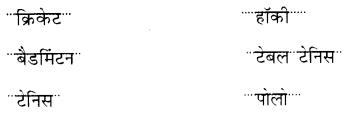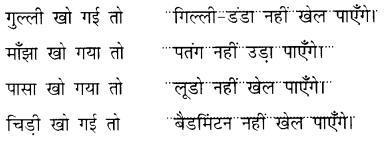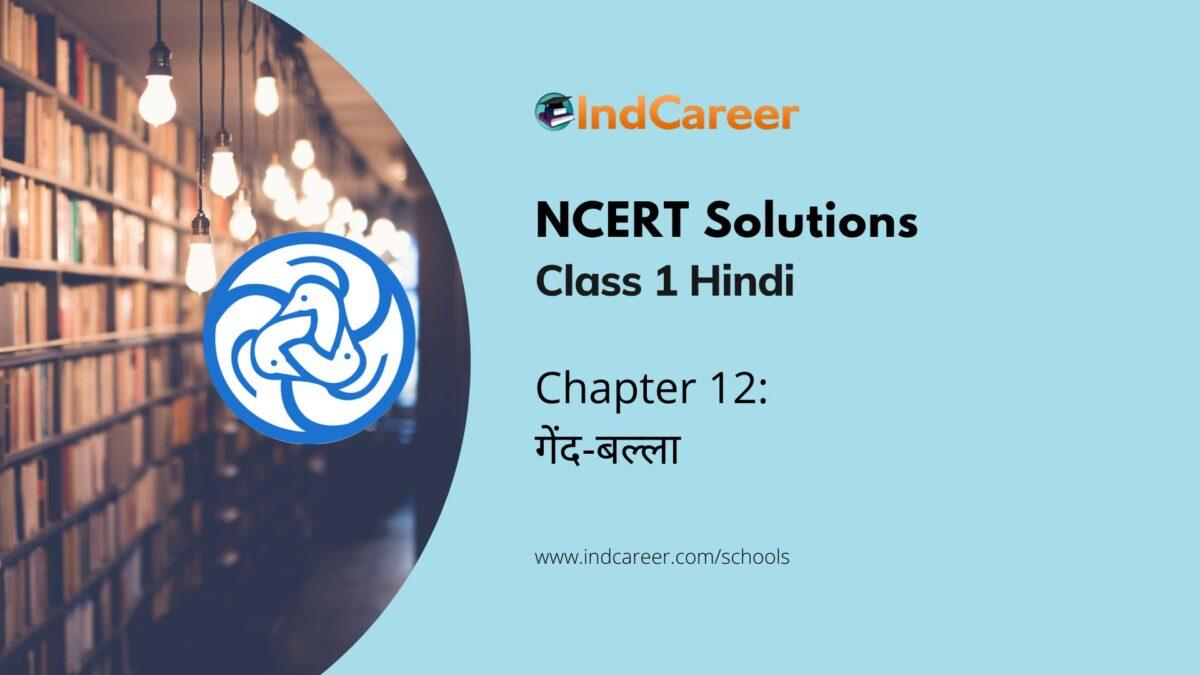Chapter 12 of the NCERT Hindi textbook for Class 1 is titled “गेद-बल्ला” (Gend Balla), which translates to “Ball and Bat.” This chapter presents a light-hearted story revolving around the playful relationship between a ball (गेंद) and a bat (बल्ला).
In the story, the ball expresses its concern to the bat about being hit repeatedly. It asks the bat why it keeps hitting it. The bat responds that without hitting the ball, the game cannot be played. This playful exchange highlights the dynamics of their relationship, where the bat’s actions are essential for the game, but they also cause the ball distress.
As the story progresses, the ball decides to hide in a bush after being hit hard by the bat. The bat, worried about the ball’s absence, searches for it frantically. The ball takes pleasure in the bat’s concern, which adds a humorous touch to the narrative. Eventually, as darkness falls and the bat prepares to give up the search, the ball reveals its location, prompting the bat to retrieve it. The ball then pleads with the bat not to hit it anymore.
Contents
NCERT Solutions for Class 1st Hindi: Chapter 12-गेंद-बल्ला
This chapter is designed to be simple and relatable for Class 1 students, encouraging them to engage with the Hindi language through storytelling and interactive learning.
Key Themes
- Friendship: The playful yet caring relationship between the ball and bat.
- Communication: The importance of expressing feelings and concerns.
- Playfulness: The light-hearted nature of childhood games and interactions.
This chapter is designed to be simple and relatable for Class 1 students, encouraging them to engage with the Hindi language through storytelling and interactive learning.
NCERT 1st Hindi Chapter 12, class 1 Hindi Chapter 12 solutions
कहानी का सारांश
प्रस्तुत कहानी गेंद और बल्ले की है। गेंद ने बल्ले से कहा कि तुम मुझे क्यों मारते हो? बल्ले ने उत्तर दिया कि यदि मैं तुम्हें मारूंगा नहीं तो खेल कैसे होगा? फिर जब गेंद बल्ले के पास आई तो उसने जोर से उसे मारा। गेंद कूदती फुदकती दूर जाकर एक झाड़ी में छिप गई। बल्ला गेंद को ढूंढता रहा, किंतु गेंद नहीं मिली। शाम हो गई। बल्ले को परेशान देखकर गेंद खुश हो रही थी। जब अँधेरा घिरने लगा तो बल्ला निराश होकर लौटने लगा। तभी झाड़ी से गेंद ने चिल्लाकर कहा कि मैं यहाँ हूँ। बल्ले ने झाड़ी से खींचकर गेंद को उठा लिया। गेंद ने बल्ले से कहा कि अब मुझे मत मारना।
शब्दार्थ : बल्ला-गेंद मारने का लकड़ी का चपटा डंडा। फुदकना-उछल-कूद करना।
प्रश्न-अभ्यास
(पाठ्यपुस्तक से)
प्रश्न 1.
गिल्ली डंडे के खेल में गिल्ली को डंडे से मारते हैं। कुछ और खेल बताओ, जिसमें एक चीज़ को दूसरी से मारा जाता है।
उत्तर :

प्रश्न 2.
गेंद खो गई तो गेंद-बल्ला नहीं खेल पाएँगे।
उत्तर :

प्रश्न 3.
अगर तुम्हारे घर में गेंद खो गई तो कहाँ-कहाँ हूँढ़ोगे?
उत्तर :

NCERT Solutions for Class 1st Hindi: Chapter 12: Download PDF
NCERT Solutions for Class 1st Hindi: Chapter 12-गेंद-बल्ला
Download PDF: NCERT Solutions for Class 1st Hindi: Chapter 12-गेंद-बल्ला PDF
Activities Related to Chapter 12: गेद-बल्ला
Fun Games and Exercises for Kids: Engaging children with activities related to the story “गेद-बल्ला” (Gend Balla) can enhance their understanding and enjoyment of the chapter. Here are some fun games and exercises that can be conducted:
- Ball and Bat Game
- Objective: Reinforce the relationship between the ball and bat.
- How to Play: Set up a small area where children can play a simplified version of cricket. Use a soft ball and bat, and let them take turns hitting the ball. Discuss how the bat and ball work together in the game, mirroring the story’s theme.
- Story Role Play
- Objective: Encourage creativity and comprehension.
- How to Play: Divide the children into pairs or small groups. Assign roles (the ball and the bat) and have them act out scenes from the story. This will help them grasp the emotions and dynamics between the characters.
- Drawing Activity
- Objective: Enhance artistic expression.
- How to Play: Ask children to draw their favorite scene from the chapter. They can illustrate the ball hiding in the bush or the bat searching for it. This activity will allow them to visualize the story and express their creativity.
- Vocabulary Matching
- Objective: Improve language skills.
- How to Play: Create flashcards with key vocabulary words from the chapter (like गेंद, बल्ला, खेल). Have children match the words with their meanings or images. This can be a fun group activity or a competitive game.
- Discussion Questions
- Objective: Foster critical thinking.
- How to Play: After reading the chapter, pose questions like:
- Why do you think the ball hides?
- How does the bat feel when it can’t find the ball?
- Encourage children to express their thoughts and feelings about the story.
- Ball Hunt
- Objective: Active play and problem-solving.
- How to Play: Hide a soft ball around the play area and give clues to the children to find it. This mimics the ball hiding in the story and adds an element of excitement.
- Create Your Own Story
- Objective: Encourage imagination.
- How to Play: Ask children to write or narrate their own story involving a ball and bat. They can create new adventures or challenges for the characters, promoting creativity and writing skills.
- Worksheet Activities
- Sing a Song
- Objective: Make learning fun through music.
- How to Play: Create a simple song about the ball and bat, incorporating key phrases from the chapter. Singing can help reinforce vocabulary and make the story memorable.
- Parent-Child Interaction
- Objective: Involve parents in learning.
- How to Play: Encourage parents to read the chapter with their children and discuss it afterward. They can ask questions and share their own childhood experiences related to games, fostering a deeper connection to the story.
These activities not only make learning enjoyable but also help reinforce the themes and vocabulary from Chapter 12, “गेद-बल्ला,” ensuring that children grasp the story’s essence while having fun.
Chapterwise NCERT Solutions for Class 1 Hindi :
- Chapter 1 – झूला
- Chapter 2 – आम की कहानी
- Chapter 3 – आम की टोकरी
- Chapter 4 – पत्ते ही पत्ते
- Chapter 5 – पकौड़ी
- Chapter 6 – छुक-छुक गाड़ी
- Chapter 7 – रसोईघर
- Chapter 8 – चूहो! म्याऊँ सो रही है
- Chapter 9 – बंदर और गिलहरी
- Chapter 10 – पगड़ी
- Chapter 11 – पतंग
- Chapter 12 – गेंद-बल्ला
- Chapter 13 – बंदर गया खेत में भाग
- Chapter 14 – एक बुढ़िया
- Chapter 15 – मैं भी……
- Chapter 16 – लालू और पीलू
- Chapter 17 – चकई के चकदुम
- Chapter 18 – छोटी का कमाल
- Chapter 19 – चार चने
- Chapter 20 – भगदड़
- Chapter 21 – हलीम चला चाँद पर
- Chapter 22 – हाथी चल्लम चल्लम
- Chapter 23 – सात पूँछ का चूहा
FAQs
The main theme of Chapter 12, “गेद-बल्ला,” revolves around friendship and communication. The story illustrates the playful relationship between the ball and the bat, highlighting how they interact during play and the importance of expressing feelings in relationships. The ball’s fear of being hit and the bat’s need to hit it for the game to continue reflect the dynamics of their friendship.
Parents can assist their children by reading the chapter together, discussing the characters and their feelings, and encouraging them to express their thoughts about the story. Engaging in related activities, such as role-playing or drawing scenes from the story, can also enhance comprehension and make learning enjoyable.
Yes, additional resources such as worksheets, online videos, and NCERT solutions are available for Class 1 Hindi. Websites like Vedantu and Learn CBSE provide free downloadable resources, including summaries and exercises related to the chapters, which can aid in exam preparation.
Key vocabulary words from Chapter 12 include:
गेंद (Gend) – Ball
बल्ला (Balla) – Bat
खेल (Khel) – Game
फुदकना (Phudakna) – To jump or hop
About NCERT
The National Council of Educational Research and Training is an autonomous organization of the Government of India which was established in 1961 as a literary, scientific, and charitable Society under the Societies Registration Act. The major objectives of NCERT and its constituent units are to: undertake, promote and coordinate research in areas related to school education; prepare and publish model textbooks, supplementary material, newsletters, journals and develop educational kits, multimedia digital materials, etc
Organise pre-service and in-service training of teachers; develop and disseminate innovative educational techniques and practices;collaborate and network with state educational departments, universities, NGOs and other educational institutions; act as a clearing house for ideas and information in matters related to school education; and act as a nodal agency for achieving the goals of Universalisation of Elementary Education.
The National Council of Educational Research and Training is an autonomous organization of the Government of India which was established in 1961 as a literary, scientific, and charitable Society under the Societies Registration Act. Its headquarters are located at Sri Aurbindo Marg in New Delhi. Visit the Official NCERT website to learn more.
